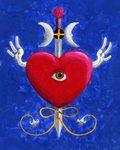Date of death: October 13,1961 New York
Cause of death: cerebral hemmorhage. NOTE: there is a great deal of
unfounded speculation about Deren's death which is in part generated
as a result of the fact that Deren was a practitioner of Haitian Voudoun. The later Stan
Brakhage promotes this view in Film at Wit's End , a generally patronizing and
not totally reliable account of Deren's work- as well as in interviews in both documentary films made about Deren to date ( by JoAnn Kaplan, and Martina Kudlacek).
Voudoun is generally discredited as a major world religion - a practice based on racism - which Deren worked to correct in scholarship and lectures,
Deren's use of medically prescribed amphetamines most probably was the most significant factor attributed to her early death. She was beset by grief that her husband Teiji had been drafted and was majorly inconvenienced
by a persistant bad economy during her brief career as an artist, ethnographer
and producer of independent films.
Short Biography:
Maya Deren came to America in 1922 as Eleanora Derenkowsky. Together
with her father, a psychiatrist --and her mother, an artist, she fled the pogroms
against Russian Jews. She studied journalism and political science in at Syracuse University
in New York , finishing her B.A up at NYU in June 1936,
and then received her Master's degree in English literature from Smith in 1939.
In 1943 she made her first film with Alexander Hammid called "Meshes of
the Afternoon "(1943). Through this association she changed her name
to Maya at Hammid's suggestion--Maya, a Buddhist term meaning 'illusion'. She made six short
films: "Meshes of the Afternoon" (1943), " At Land" (1944), "A Study for Choreography for Camera" (1945),
"Ritual in Transfigured Time"(1945-1946), "Meditation on Violence" (1947), "The Very Eye of Night"(1959)
and several incomplete films including one with Marcel Duchamp entitled
"The Witches Cradle" ( 1944).
Deren is the author of two books: "An Anagram of Ideas on Art, Form and Film" 1946
(reprinted in The Legend Of Maya Deren, vol 1, part 2)
and " Divine Horsemen : The Living Gods of Haiti " (1953)
--a book that was made after her first trip to Haiti in 1947 and which is still considered
one of the most useful on Haitian Voudoun. (Creole form adopted by Deren)
Deren wrote numerous articles on film and on Haiti .
See "Bibliography of Maya Deren's Articles and Monographs compiled by Moira Sullivan"
Maya Deren shot over 18,000 feet in Haiti from 1947-1954 on Haitian Voudoun ,
parts of which can be viewed in an assembled video made after her death by
her husband Teiji Ito and his new wife Cherel: Divine Horsemen:Living Gods of Haiti.
Maya Deren was the first filmmaker to receive a Guggenheim
for creative work in motion pictures (1947). She wrote film theory, distributed her own films, traveled across the USA and to
Cuba and Canada to promote her films using the lecture-demonstration format
to inform on film theory as well as Voudoun and the interrelationship of magic,
science and religion. Deren stablished the Creative Film Foundation
in the late 1950's to reward the achievements of independent filmmakers.
Gregory Bardacke (divorced)
Alexander Hammid (divorced)
Teiji Ito (married to at time of death)
Biographical movies
Invocation: Maya Deren , Jo Ann Kaplan, narrator, Helen Mirren (1987)
In the Mirror of Maya Deren, Martina Kudlacek (2001)
Biography writer Moira Sullivan





No comments:
Post a Comment